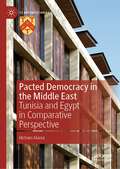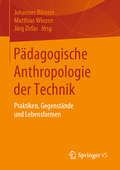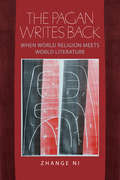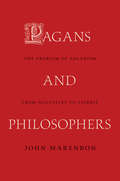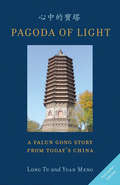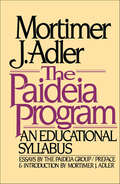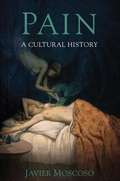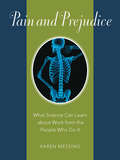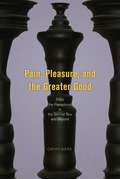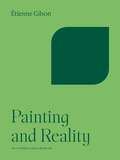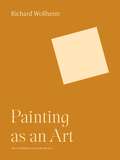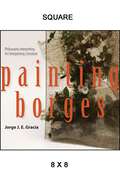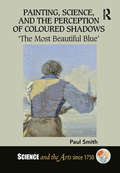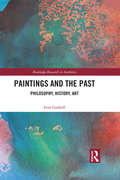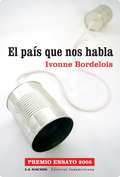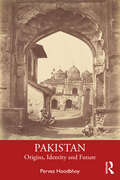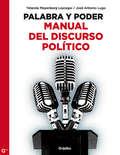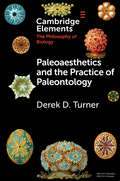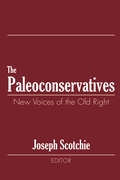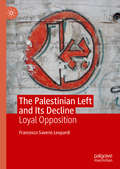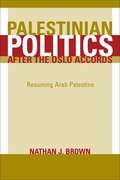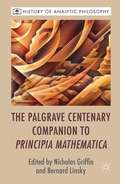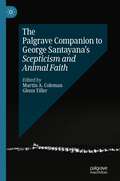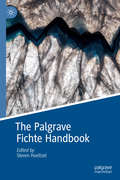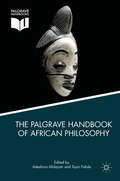- Table View
- List View
Pacted Democracy in the Middle East: Tunisia and Egypt in Comparative Perspective (St Antony's Series)
by Hicham AlaouiThis book provides a new theory for how democracy can materialize in the Middle East, and the broader Muslim world. It shows that one pathway to democratization lays not in resolving important, but often irreconcilable, debates about the role of religion in politics. Rather, it requires that Islamists and their secular opponents focus on the concerns of pragmatic survival—that is, compromise through pacting, rather than battling through difficult philosophical issues about faith. This is the only book-length treatment of this topic, and one that aims to redefine the boundaries of an urgent problem that continues to haunt struggles for democracy in the aftermath of the Arab Spring.
Pädagogische Anthropologie der Technik: Praktiken, Gegenstände und Lebensformen
by Johannes Bilstein Matthias Winzen Jörg ZirfasDer Band geht der Frage nach, welche spezifisch edukativen Techniken angesichts der zunehmenden Etablierung und Professionalisierung der pädagogischen Arbeitsfelder erforderlich werden. In diesem Zusammenhang wird zu klären versucht, welche pädagogische und didaktische Vorbereitung auf eine zunehmend technisch orientierte Welt erfolgen muss. Zudem werden die alltäglichen Techniken der Selbstsorge analysiert. Und schließlich geht es in einer Pädagogischen Anthropologie auch um die Frage, wer Subjekt und Objekt der Technik ist.
The Pagan Writes Back: When World Religion Meets World Literature (Studies in Religion and Culture)
by Zhange NiIn the first book to consider the study of world religion and world literature in concert, Zhange Ni proposes a new reading strategy that she calls "pagan criticism," which she applies not only to late twentieth- and early twenty-first-century literary texts that engage the global resurgence of religion but also to the very concepts of religion and the secular. Focusing on two North American writers (the Jewish American Cynthia Ozick and the Canadian Margaret Atwood) and two East Asian writers (the Japanese Endō Shūsaku and the Chinese Gao Xingjian), Ni reads their fiction, drama, and prose to envision a "pagan (re)turn" in the study of world religion and world literature. In doing so, she highlights the historical complexities and contingencies in literary texts and challenges both Christian and secularist assumptions regarding aesthetics and hermeneutics. In assessing the collision of religion and literature, Ni argues that the clash has been not so much between monotheistic orthodoxies and the sanctification of literature as between the modern Western model of religion and the secular and its non-Western others. When East and West converge under the rubric of paganism, she argues, the study of religion and literature develops into that of world religion and world literature.
Pagans and Philosophers
by John MarenbonFrom the turn of the fifth century to the beginning of the eighteenth, Christian writers were fascinated and troubled by the "Problem of Paganism," which this book identifies and examines for the first time. How could the wisdom and virtue of the great thinkers of antiquity be reconciled with the fact that they were pagans and, many thought, damned? Related questions were raised by encounters with contemporary pagans in northern Europe, Mongolia, and, later, America and China. Pagans and Philosophers explores how writers--philosophers and theologians, but also poets such as Dante, Chaucer, and Langland, and travelers such as Las Casas and Ricci--tackled the Problem of Paganism. Augustine and Boethius set its terms, while Peter Abelard and John of Salisbury were important early advocates of pagan wisdom and virtue. University theologians such as Aquinas, Scotus, Ockham, and Bradwardine, and later thinkers such as Ficino, Valla, More, Bayle, and Leibniz, explored the difficulty in depth. Meanwhile, Albert the Great inspired Boethius of Dacia and others to create a relativist conception of scientific knowledge that allowed Christian teachers to remain faithful Aristotelians. At the same time, early anthropologists such as John of Piano Carpini, John Mandeville, and Montaigne developed other sorts of relativism in response to the issue. A sweeping and original account of an important but neglected chapter in Western intellectual history, Pagans and Philosophers provides a new perspective on nothing less than the entire period between the classical and the modern world.
Pagoda of Light: A Falun Gong Story from Today's China
by Yuan Meng Long TuThis true story of the Bai Family in China traces how their devotion to truth placed them on a collision course with the Communist Party. When they became practitioners of Falun Gong, it paved the way for a painful and torturous, yet enlightening, path in life, especially for the two brilliant brothers Xiaojun and Shaohua. After the Chinese Communist regime began its systematic repression of Falun Gong practitioners in 1999, Bai Xiaojun was tortured to death in one of the laogai or "re-education through labour" camps. His brother Bai Shaohua also disappeared in another such prison for three years. Through blood and sweat, Shaohua made it alive out of prison but was once again abducted in early February, 2008. The details in this gripping account of how Falun Gong practitioners are being repressed reveal the larger pattern of life, and death, under a totalitarian regime. Authors Long Tu and Yuan Meng, now living in Canada, compiled this account through personal contact with members of the Bai Family. They also write from personal experience. Long Tu is a computer program designer and Yuan Meng an architect and urban designer. Yuan Meng was herself imprisoned for 16 months in a laogai camp before leaving China, where unusual "meals" caused her body to swell and her back bones were broken during the persecution. They now live in Toronto and wrote Pagoda of Light to honour their imprisoned friends, noting that "the experience of the Bai family is but one of thousands of examples."
Paideia Program: An Educational Syllabus
by The Paideia GroupPaideia is a holistic approach to life-long learning with roots in ancient Greece.The Paideia Program is based on the belief that the human species is defined by its capacity and desire for learning. The program itself argues for a public education that is at once more rigorous and more accessible.
Pain
by Javier MoscosoPain almost always lacks justification, but it does have a story. The gestures of the virgin martyrs, the mockery that accompanied Don Quixote's misadventures, the concealed penitence that took place inside convents, the little comedies of sexual masochism, the early modern anatomical theatres, the grimaces of anesthetized patients, the conscious pains of nervous disorders or the unconscious pains of mental illness all meet one another in this book. Contrary to the claims of the philosopher Cioran, who asserted that it was impossible to hold a conversation with physical pain, each and every one of these pages advocates for such an encounter and promotes such dialogue. Halfway between history and philosophy, this book deals with the successive (though not progressive) forms in which the experience of pain materializes the artistic, juridical, or scientific modalities that have permitted the cultural understanding of human suffering from the Renaissance to the present day. Representation, sympathy, imitation, but also coherence, trust, or narrativity are but a few of the rhetorical and argumentative recourses that men and women have employed, and continue to use, in order to feel our pain but also in order to express it, and to imbue it with meaning and collective value. "
Pain and Prejudice: What Science Can Learn About Work From The People Who Do It
by Dr Karen MessingIn 1978, when workers at a nearby phosphate refinery learned that the ore they processed was contaminated with radioactive dust, Karen Messing, then a new professor of molecular genetics, was called in to help. Unsure of what to do with her discovery that exposure to the radiation was harming the workers and their families, Messing contacted senior colleagues but they wouldn’t help. Neither the refinery company nor the scientific community was interested in the scary results of her chromosome studies. Over the next decades Messing encountered many more cases of workers around the world—factory workers, cleaners, checkout clerks, bank tellers, food servers, nurses, teachers—suffering and in pain without any help from the very scientists and occupational health experts whose work was supposed to make their lives easier. Arguing that rules for scientific practice can make it hard to see what really makes workers sick, in Pain and Prejudice Messing tells the story of how she went from looking at test tubes to listening to workers.
Pain, Pleasure, and the Greater Good: From the Panopticon to the Skinner Box and Beyond
by Cathy GereHow should we weigh the costs and benefits of scientific research on humans? Is it right that a small group of people should suffer in order that a larger number can live better, healthier lives? Or is an individual truly sovereign, unable to be plotted as part of such a calculation? These are questions that have bedeviled scientists, doctors, and ethicists for decades, and in Pain, Pleasure, and the Greater Good, Cathy Gere presents the gripping story of how we have addressed them over time. Today, we are horrified at the idea that a medical experiment could be performed on someone without consent. But, as Gere shows, that represents a relatively recent shift: for more than two centuries, from the birth of utilitarianism in the eighteenth century, the doctrine of the greater good held sway. If a researcher believed his work would benefit humanity, then inflicting pain, or even death, on unwitting or captive subjects was considered ethically acceptable. It was only in the wake of World War II, and the revelations of Nazi medical atrocities, that public and medical opinion began to change, culminating in the National Research Act of 1974, which mandated informed consent. Showing that utilitarianism is based in the idea that humans are motivated only by pain and pleasure, Gere cautions that that greater good thinking is on the upswing again today and that the lesson of history is in imminent danger of being lost. Rooted in the experiences of real people, and with major consequences for how we think about ourselves and our rights, Pain, Pleasure, and the Greater Good is a dazzling, ambitious history.
Painting and Reality (The A. W. Mellon Lectures in the Fine Arts #4)
by Etienne GilsonA classic study of the art of painting and its relationship to reality In this book, Étienne Gilson puts forward a bold interpretation of the kind of reality depicted in paintings and its relation to the natural order. Drawing on insights from the writings of great painters—from Leonardo, Reynolds, and Constable to Mondrian and Klee—Gilson shows how painting is foreign to the order of language and knowledge. Painting, he argues, seeks to add new beings to nature, not to represent those that already exist. For this reason, we must distinguish it from another art, that of picturing, which seeks to produce images of actual or possible beings. Though pictures play an important part in human life, they do not belong in the art of painting. Through this distinction, Gilson sheds new light on the evolution of modern painting. A magisterial work of scholarship by an acclaimed historian of philosophy, Painting and Reality features paintings from both classical and modern schools, and includes extended selections from the writings of Reynolds, Delacroix, Gris, Gill, and Ozenfant.
Painting as an Art (The A. W. Mellon Lectures in the Fine Arts #33)
by Richard WollheimOne of the twentieth century’s most influential texts on philosophical aestheticsPainting as an Art is acclaimed philosopher Richard Wollheim’s encompassing vision of how to view art. Transcending the traditional boundaries of art history, Wollheim draws on his three great passions—philosophy, psychology, and art—to present an illuminating theory of the very experience of art. He shows how to unlock the meaning of a painting by retrieving—almost reenacting—the creative activity that produced it. In order to fully appreciate a work of art, Wollheim argues, critics must bring a much richer conception of human psychology than they have in the past. This classic book points the way to discovering what is most profound and subtle about paintings by major artists such as Titian, Bellini, and de Kooning.
Painting Borges: Philosophy Interpreting Art Interpreting Literature (SUNY series in Latin American and Iberian Thought and Culture)
by Jorge J. GraciaIn this groundbreaking book, Jorge J. E. Gracia explores the artistic interpretation of fiction from a philosophical perspective. Focusing on the work of Jorge Luis Borges, one of the most celebrated literary figures of Latin America, Gracia offers original interpretations of twelve of Borges's most famous stories about identity and memory, freedom and destiny, and faith and divinity. He also examines twenty-four artistic interpretations of these stories—two for each—by contemporary Argentinean and Cuban artists such as Carlos Estévez, León Ferrari, Mirta Kupferminc, Nicolás Menza, and Estela Pereda. This philosophical exploration of how artists have interpreted literature contributes to both aesthetics and hermeneutics, makes new inroads into the understanding of Borges's work, and introduces readers to two of the most vibrant artistic currents today. Color images of the artworks discussed are included.
Painting, Science, and the Perception of Coloured Shadows: ‘The Most Beautiful Blue’ (Science and the Arts since 1750)
by Paul SmithMany artists and scientists – including Buffon, Goethe, and Philipp Otto Runge – who observed the vividly coloured shadows that appear outdoors around dawn and dusk, or indoors when a candle burns under waning daylight, chose to describe their colours as ‘beautiful’. Paul Smith explains what makes these ephemeral effects worthy of such appreciation – or how depictions of coloured shadows have genuine aesthetic and epistemological significance. This multidisciplinary book synthesises methodologies drawn from art history (close pictorial analysis), psychology and neuroscience (theories of colour constancy), history of science (the changing paradigms used to explain coloured shadows), and philosophy (theories of perception and aesthetic value drawn from Wittgenstein and Merleau-Ponty). This title will be of interest to scholars in art history, art theory, and the history of science and technology.
Paintings and the Past: Philosophy, History, Art (Routledge Research in Aesthetics)
by Ivan GaskellThis book is an exploration of how art—specifically paintings in the European manner—can be mobilized to make knowledge claims about the past. No type of human-made tangible thing makes more complex and bewildering demands in this respect than paintings. Ivan Gaskell argues that the search for pictorial meaning in paintings yields limited results and should be replaced by attempts to define the point of such things, which is cumulative and ever subject to change. He shows that while it is not possible to define what art is—other than being an open kind—it is possible to define what a painting is, as a species of drawing, regardless of whether that painting is an artwork or not at any given time. The book demonstrates that things can be artworks on some occasions but not necessarily on others, though it is easier for a thing to acquire artwork status than to lose it. That is, the movement of a thing into and out of the artworld is not symmetrical. All such considerations are properly matters not of ontology—what is and what is not an artwork—but of use; that is, how a thing might or might not function as an artwork under any given circumstances. These considerations necessarily affect the approach to paintings that at any given time might be able to function as an artwork or might not be able to function as such. Only by taking these factors into account can anyone make viable knowledge about the past. This lively discussion ranges over innumerable examples of paintings, from Rembrandt to Rothko, as well as plenty of far less familiar material from contemporary Catholic devotional works to the Chinese avant garde. Its aim is to enhance philosophical acuity in respect of the analysis of paintings, and to increase their amenability to philosophically satisfying historical use. Paintings and the Past is a must-read for all advanced students and scholars concerned with philosophy of art, aesthetics, historical method, and art history.
PAIS QUE NOS HABLA, EL (EBOOK)
by Ivonne BordeloisCuáles son los peligros y las amenazas que nos acechan en relación con esa riqueza fundamental de todo pueblo que es su lengua? Qué podemos hacer para conjurarlos? La campaña de devastación verbal que realizan los medios nos prepara para ser zombies de la sociedad de consumo y nos priva de la riqueza del idioma, que no sólo es comunicación sino sabiduría e identidad. El país que nos habla, de Ivonne Bordelois, intenta señalar un camino en ese sentido.
Pakistan: Origins, Identity and Future
by Pervez HoodbhoyThis book is an accessible, comprehensive, and nuanced history of Pakistan. It reflects upon state and society in Pakistan and shows they have been shaped by historical forces and personae. Hoodbhoy expertly maps the journey of the region from many millennia ago to the circumstances and impulses that gave birth to the very first state in history founded upon religious identity. He documents colonial rule, the trauma of Partition, the nation’s wars with India, the formation of Bangladesh, and the emergence of Baloch nationalism. The book also examines longstanding complex themes and issues – such as religious fundamentalism, identity formation, democracy, and military rule – as well as their impact on the future of the state of Pakistan. Drawing on a range of sources and written by one of the foremost intellectuals of the region, this book will be indispensable for scholars, researchers, students of history, politics, and South Asian studies. It will be of great interest to the general reader interested in understanding Pakistan.
Palabra y poder:
by Yolanda Meyemberg LeyceguiEl discurso político tiene el objetivo fundamental de persuadir a un grupo social para que realice un acto determinado: emitir un voto, avalar una política específica, refrendar una iniciativa, etcétera. Por ello, un discurso eficaz requiere estar construido sobre una base retórica que garantice la implantación del mensaje en la mente del receptor; esto es, que lo convenza de sus argumentos el emisor. El discurso es también un instrumento de legitimación política, fundamental para conocer las posiciones ideológicas de los líderes sociales, de la propia sociedad y de los medios de comunicación. Su vigencia a lo largo de la historia como medio persuasivo tiene que ver con la eficacia con la que logra sus fines: desde la antigua Grecia hasta la actualidad los escritores de discursos han recurrido a diversa técnicas comunicativas tanto para organizarlos como para pronunciarlos ante un ágora determinada. Palabra y poder: Manual del discurso político es una herramienta que proporciona reglas y conceptos prácticos para elaborar un discurso claro, ordenado y eficaz. La obra está dirigida a quienes desempeñan la difícil tarea de redactar los mensajes que de manera cotidiana pronuncian los políticos en la arena pública. Los autores, Yolanda Meyenberg y José Antonio Lugo, han dedicado parte de su vida profesional a la construcción de discursos como piezas retóricas cuya finalidad es informar sobre los actos de gobierno, afianzar la imagen de la autoridad y legitimar sus acciones. Así, al finalizar la lectura de este libro, el lector será capaz de elaborar un discurso de calidad, no sólo en cuanto a su aspecto literario, sino también en relación con la solidez de sus argumentos retóricos.
Paleoaesthetics and the Practice of Paleontology (Elements in the Philosophy of Biology)
by Derek D. TurnerThe practice of paleontology has an aesthetic as well as an epistemic dimension. Paleontology has distinctively aesthetic aims, such as cultivating sense of place and developing a better aesthetic appreciation of fossils. Scientific cognitivists in environmental aesthetics argue that scientific knowledge deepens and enhances our appreciation of nature. Drawing on that tradition, this Element argues that knowledge of something's history makes a difference to how we engage with it aesthetically. This means that investigation of the deep past can contribute to aesthetic aims. Aesthetic engagement with fossils and landscapes is also crucial to explaining paleontology's epistemic successes.
The Paleoconservatives: New Voices of the Old Right
by Joseph A. Scotchie"Paleoconservatism" as a concept came into circulation during the 1980s as a rejoinder to the rise of neoconservatism. It signifies a brand of conservatism that rose up in opposition to the New Deal, setting itself against the centralizing trends that define modern politics to champion the republican virtues of self-governance and celebrate the nation's varied and colorful regional cultures. This volume brings together key writings of the major representatives of "Old Right" thought, past and present. The essays included here define a coherent intellectual tradition linking New York libertarians to unreconstructed Southern traditionalists to Midwestern agrarians. Part I is devoted to the founding fathers of the modern conservative movement. Essays by Frank Chodorov, Murray Rothbard, and James Burnham attack economic aspects of the New Deal, big government in general, and high taxes. Russell Kirk introduces the cultural paleoconservatism, with its preference for social classes and distinctions of age and sex, while Richard Weaver explains why culture is more important to a civilization's survival than mere material conditions. The second part covers the contemporary resurgence of the Old Right. Chilton Williamson, Jr. sets out the argument against large-scale immigration on cultural and economic grounds. The divisive issue of trade is covered. William Hawkins outlines a mercantilist trade policy at odds with the free trade libertarianism of Chodorov and Rothbard. On education, Allan Carlson goes further than the Beltway Right in his advocacy of home schooling. M.E. Bradford shows how the doctrine of equality of opportunity inevitably leads to greater and more tyrannical state action. The contemporary culture wars are the focus of Thomas Fleming, Paul Gottfried, Clyde Wilson, and Samuel Francis, who search for the roots of American nationalism, the lessons to be drawn from the past, and how they may be applied in the future.
The Palestinian Left and Its Decline: Loyal Opposition
by Francesco Saverio LeopardiThis book examines the history of the Palestinian Left by focusing on the trajectory of the Popular Front for the Liberation of Palestine (PFLP) during its declining phase. Relying on a substantial corpus of primary sources, this study illustrates how the PFLP’s political agency contributed to its own marginalisation within the Palestinian national movement. Following the 1982 eviction of the Palestine Liberation Organisation (PLO) from Lebanon, the bases of the PFLP’s opposition to Fatah’s primacy in the national movement were jeopardised. This book argues that the PFLP’s «loyalty» to the PLO institutional and political framework prevented the formulation of a real counterhegemonic political project. This drove the PFLP’s action to suffer a fundamental contradiction undermining its stance within the national movement. In the attempt to continue its opposition to Fatah, while maintaining integration in the Palestinian mainstream, the PFLP’s agency fluctuated, compromising its effectiveness and credibility. Apparently irreversible, the PFLP’s marginalisation is a factor fostering the current Palestinian impasse, as no alternative is emerging to break the thirteen-year long Hamas-Fatah polarisation.
Palestinian Politics after the Oslo Accords: Resuming Arab Palestine
by Nathan J. BrownThis timely and critically important work does what hostilities in the Middle East have made nearly impossible: it offers a measured, internal perspective on Palestinian politics, viewing emerging political patterns from the Palestinian point of view rather than through the prism of the Arab-Israeli conflict.
The Palgrave Centenary Companion To Principia Mathematica
by Nicholas Griffin Bernard LinskyTo mark the centenary of the 1910 to 1913 publication of the monumental Principia Mathematica by Alfred N. Whitehead and Bertrand Russell, this collection of fifteen new essays by distinguished scholars considers the influence and history of PM over the last hundred years.
The Palgrave Companion to George Santayana’s Scepticism and Animal Faith (Palgrave Companions)
by Martin A. Coleman Glenn TillerThe first of its kind, this project is a collection of critical and interpretive essays on George Santayana’s seminal work in American philosophy, Scepticism and Animal Faith (1923), 100 years after its first edition. The reader will be guided through the intricacies of Scepticism and Animal Faith by expert scholars. This book is a companion to Scepticism and Animal Faith for both first-time readers and readers intimately familiar with this work.
The Palgrave Fichte Handbook (Palgrave Handbooks in German Idealism)
by Steven HoeltzelThis Handbook provides a comprehensive single-volume treatment of Fichte’s philosophy. In addition to offering new researchers an authoritative introduction and orientation to Fichtean thought, the volume also surveys the main scholarly and philosophical controversies regarding Fichtean interpretation, and defends a range of philosophical theses in a way that advances the scholarly discussion. Fichte is the first major philosopher in the post-Kantian tradition and the first of the great German Idealists, but he was no mere epigone of Kant or precursor to Hegel. His work speaks powerfully and originally to a wide range of issues of enduring concern, and his many innovations importantly anticipate major developments, including absolute idealism, phenomenology, and existentialism. He is therefore not only a path-breaking thinker but also a pivotal figure in Western intellectual history. Wide-ranging, well-organised and timely, this key volume makes Fichte’s work both accessible and relevant. It is essential reading for scholars, graduate researchers and advanced students interested in Fichte, German Idealism, and the history of nineteenth-century philosophy in the West.
The Palgrave Handbook of African Philosophy
by Adeshina Afolayan Toyin FalolaThis handbook investigates the current state and future possibilities of African Philosophy, as a discipline and as a practice, vis-#65533;-vis the challenge of African development and Africa's place in a globalized, neoliberal capitalist economy. The volume offers a comprehensive survey of the philosophical enterprise in Africa, especially with reference to current discourses, arguments and new issues--feminism and gender, terrorism and fundamentalism, sexuality, development, identity, pedagogy and multidisciplinarity, etc. --that are significant for understanding how Africa can resume its arrested march towards decolonization and liberation.
